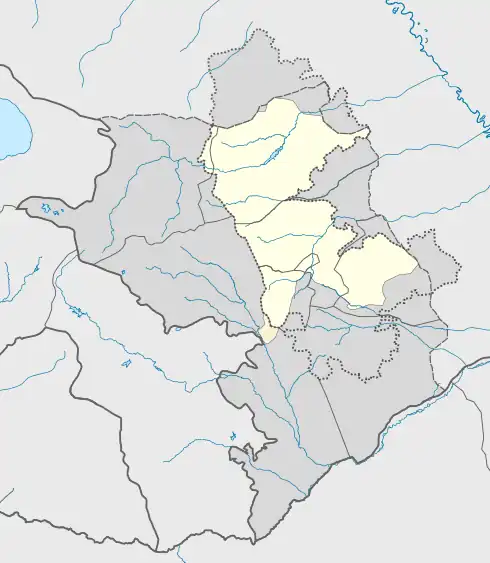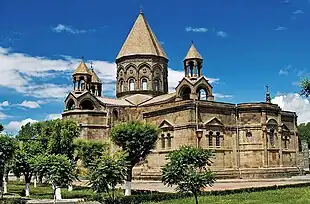Havaptuk monastery
Havaptuk Monastery (Armenian: Հավապտուկ վանք), also known as Havotsptuk (Armenian: Հավոցպտուկ), is a medieval Armenian monastery, which is situated near the village of Vank, in the disputed region of Nagorno-Karabakh, de facto in the Republic of Artsakh, de jure in Azerbaijan.[1]
| Havaptuk Monastery | |
|---|---|
| |
| Religion | |
| Affiliation | Armenian Apostolic Church |
| Region | Martakert Province |
| Location | |
| Location | 5 km from the village of Vank |
| Country | Republic of Artsakh (de facto) Azerbaijan (de jure) |
 Shown within Republic of Artsakh  Havaptuk monastery (Azerbaijan) | |
| Geographic coordinates | 40.0343°N 46.5488°E |
| Architecture | |
| Type | Monastery |
| Style | Armenian |
| Date established | 1163 |
| Completed | 1233 |
The monastery complex consists of a small church, a narthex and a small church.[2] In addition to these buildings, there are also the remains of other structures. There are two cemeteries near the monastery.
Inscriptions
According to the inscriptions, the church was built in 1163 and rebuilt in 1223.[3] At the entrance to the main church of the monastery, the following inscription in Armenian has been preserved:[4]
In the summer of 612 (1163), under the principality of Hassan, the son of Vakhtang and his wife Mamkan, I, John, son of the sister of Gregory and Georg, the son of (my) brother and other brothers, built churches to save our souls and in memory of our parents...
According to another inscription, the church was restored in 1223 under the principality of Hasan-Jalal Dawla.[5]
In June 2016, during the scientific expedition in the Republic of Artsakh, new epigraphic inscriptions were discovered on many monuments, including in the Havaptuk monastery.[6]
Literature
- Mkrtchyan, Shahen (1989). Историко-архитектурные памятники Нагорного Карабаха [Historical and architectural monuments of Nagorno-Karabakh] (in Russian). Parkebarakn. p. 360. ISBN 5-540-00402-7.
References
- Mkrtchyan, Shahen (1989). Harutyunyan, V. M.; Ulubabyan, B. A. (eds.). Историко-архитектурные памятники Нагорного Карабаха [Historical and architectural monuments of Nagorno-Karabakh] (in Russian). Translated by Baghdasaryan, L. R.; Arakelyan, N. A. (2nd ed.). Yerevan: Parberakan. p. 360. ISBN 5-540-00402-7.
- "Havaptuk Monastery". artsakhdiocese.am. Diocese of Artsakh. Retrieved 9 February 2022.
- "The Churches of Artsakh". St. Nersess Armenian Seminary. Retrieved 27 November 2021.
- Mkrtchyan, Shahen (1989). Harutyunyan, V. M.; Ulubabyan, B. A. (eds.). Историко-архитектурные памятники Нагорного Карабаха [Historical and architectural monuments of Nagorno-Karabakh] (in Russian). Translated by Baghdasaryan, L. R.; Arakelyan, N. A. (2nd ed.). Yerevan: Parberakan. p. 22. ISBN 5-540-00402-7.
«В лето 612 г. (1163 г.) при княжестве Хасана сына Вахтанга и супруги его Мамкан, я тэр Иоанн, сын сестры отца тэр Григора и Георг, сын (моего) брата и другие собратья построили церкви во спасение нашей души и в память о родителях наших...»
- Mkrtchyan, Shahen (1989). Harutyunyan, V. M.; Ulubabyan, B. A. (eds.). Историко-архитектурные памятники Нагорного Карабаха [Historical and architectural monuments of Nagorno-Karabakh] (in Russian). Translated by Baghdasaryan, L. R.; Arakelyan, N. A. (2nd ed.). Yerevan: Parberakan. p. 22. ISBN 5-540-00402-7.
Согласно другой надписи церковь была восстановлена в 1223 г. при княжестве Хасан-Джалал Долы.
- "Ethnography, Archaeology, folkloristics: Interdisciplinary Approaches" (PDF). Yerevan, Armenia: National Academy of Sciences RA Institute of Archaeology and Ethnography. 29 October 2015. Retrieved 8 February 2022. p. 28}:
During the scientific expedition made in June of this year, new epigraphic inscriptions are found in the province of Khachen situated in the Republic of Nagorno-Karabakh, or Artsakh. The new inscriptions are discovered even on the monuments, which were studied and published many times, for example the monastery of Gandzasar, as well as the Havaptuk or Havotsptuk monastery



